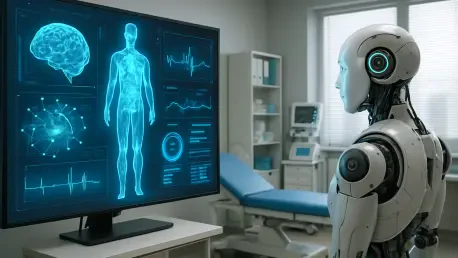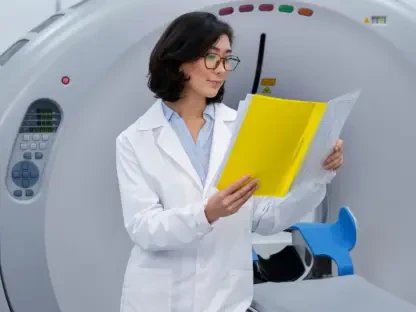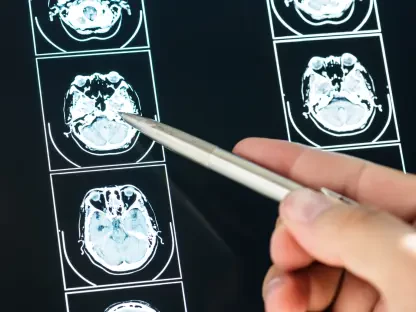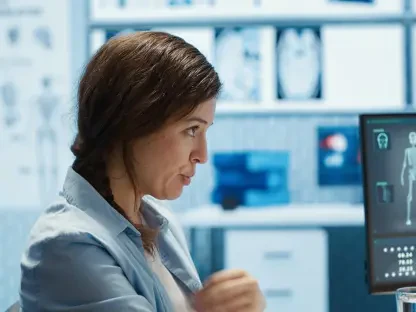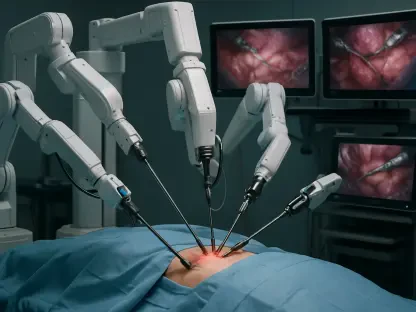Imagine a world where a smartphone app can diagnose a sore throat in seconds or a robot performs intricate surgeries with precision beyond human capability—this vision is closer to reality than many might think, thanks to cutting-edge developments in artificial intelligence. A recent fall symposium hosted by Johns Hopkins University’s Data Science and AI Institute (DSAI) on September 16 at the Homewood campus brought this future into sharp focus. Titled “AI in Daily Life,” the event gathered a dynamic mix of engineers, clinicians, researchers, and ethicists to explore how AI is poised to tackle some of health care’s most daunting challenges. From addressing surgeon shortages to enhancing diagnostic accessibility, the discussions painted a compelling picture of technology’s potential to revolutionize medicine.
Beyond the realm of health care, the symposium delved into AI’s broader societal implications, touching on ethical dilemmas and environmental impacts. The urgency of solving systemic medical issues was palpable, as was the recognition that such powerful tools come with significant responsibilities. Attendees left with a sense of both excitement and caution, aware that the path to integrating AI into everyday life is as complex as it is promising. This event served as a critical platform for showcasing tangible innovations while sparking vital conversations about the balance between progress and precaution.
Tackling Medical Challenges with AI Technology
Revolutionizing Surgery with Robotics
A critical issue facing the health care system is the projected surgeon shortage in the United States, expected to become even more severe by 2035 as surgical demand doubles. Axel Krieger, a mechanical engineer and associate professor at Johns Hopkins’ Whiting School of Engineering, presented a groundbreaking solution through AI-driven robotic systems. The Smart Tissue Autonomous Robot (STAR) and the hierarchical surgical robot transformer (SRT-H) have already shown remarkable success in performing complex surgeries on animals and lifelike models. These robots are designed to learn from observing expert surgeons, adapting to real-time challenges in the operating room and responding to human feedback. Such advancements signal a future where autonomous surgical assistance could significantly alleviate the strain on medical professionals, addressing a pressing gap in health care capacity with technology that mirrors human skill and decision-making.
The implications of robotic surgery extend beyond merely filling a shortage; they promise to enhance precision and outcomes in ways previously unimaginable. While these systems are still in experimental stages, their ability to handle intricate procedures with minimal human intervention offers hope for scalability in high-pressure environments. Krieger emphasized that full integration into human surgeries remains years away, highlighting the need for rigorous testing and regulatory approval to ensure safety. Nevertheless, the potential for these robots to work alongside surgeons—handling repetitive tasks or assisting in complex cases—could redefine operating room dynamics. This technology also raises questions about training the next generation of medical professionals to collaborate with machines, ensuring that human expertise remains central even as automation advances.
Enhancing Diagnostics for Wider Access
Mathias Unberath, director of research at DSAI and associate professor of computer science, introduced pioneering tools aimed at transforming how diagnoses are made and accessed. One such innovation, the CurieDx mobile app, developed in collaboration with pediatric emergency physician Therese Canares, allows users to upload a photo of their throat for an AI-driven analysis to screen for strep throat. The app delivers immediate results and guidance on whether medical attention is necessary, empowering individuals to make informed health decisions from the comfort of home. This tool not only reduces unnecessary visits to health care facilities but also helps curb the spread of contagious infections by enabling early detection and isolation. Such accessibility marks a significant step toward democratizing medical care, particularly for those with limited access to doctors.
Another project showcased by Unberath focuses on equipping general eye-care providers with an AI tool to detect glaucoma, a leading cause of blindness often diagnosed only by specialists. With long wait times for appointments in fields like ophthalmology, neurology, and cardiology exacerbating patient outcomes, this tool enables earlier detection and management by non-specialists. The potential to bridge the gap between general and specialized care could alleviate pressure on an overburdened system, ensuring that critical conditions are caught before they progress. While these diagnostic innovations are promising, challenges remain in scaling them for widespread adoption, including ensuring accuracy across diverse populations and integrating them into existing medical workflows. Still, the prospect of empowering both patients and providers with such technology underscores AI’s capacity to reshape health care delivery.
Exploring AI’s Wider Societal Implications
AI’s Ubiquity in Everyday Life
Rama Chellappa, interim director of DSAI, opened the symposium with a powerful reminder of how deeply AI is already embedded in daily routines, often without much notice. From navigation systems guiding drivers through traffic to voice assistants managing household tasks, the technology has become a seamless part of modern living. The emergence of generative AI chatbots has further expanded its utility, providing instant information on topics ranging from home repairs to parenting advice. This pervasive integration illustrates not just AI’s versatility but also its potential to influence nearly every sector beyond health care. As these tools become more sophisticated, their role in simplifying complex tasks and enhancing productivity across industries continues to grow, signaling a shift in how society interacts with technology on a fundamental level.
The broader impact of AI’s omnipresence also prompts a reevaluation of how dependent society has become on such systems for efficiency and convenience. While these advancements streamline life, they also raise concerns about over-reliance and the erosion of traditional skills, such as manual problem-solving or navigation without digital aids. Chellappa noted that as AI continues to evolve, its applications will likely penetrate even deeper into personal and professional spheres, potentially reshaping education, entertainment, and communication. Balancing the benefits of this integration with the need to maintain human agency remains a critical consideration. The symposium’s focus on AI’s everyday role served as a foundation for understanding its transformative power, setting the stage for discussions on both its promise and the accompanying challenges.
Ethical and Societal Challenges
John Tasioulas, a professor of ethics and legal philosophy at the University of Oxford, brought attention to one of AI’s most pressing societal risks: the potential displacement of workers as automation advances. With machines increasingly capable of performing tasks traditionally done by humans, there is a growing concern about how society might redefine value and purpose if conventional jobs diminish. Tasioulas proposed alternative avenues for fulfillment, such as cultivating personal relationships, pursuing lifelong learning, and focusing on personal growth. These suggestions sparked a philosophical debate about the role of work in a democratic society, challenging attendees to consider whether meaning can be derived from pursuits outside traditional labor structures. This ethical dilemma underscores the need for policies that address economic and social shifts driven by AI.
Beyond the question of employment, the ethical implications of AI also touch on issues of equity and access, as not all communities may benefit equally from technological advancements. The risk of widening existing disparities—whether through unequal access to AI tools or the prioritization of profit over public good—remains a significant concern. Tasioulas emphasized the importance of designing AI systems with fairness in mind, ensuring that benefits are distributed broadly rather than concentrated among a few. The symposium’s exploration of these societal challenges highlighted the necessity of proactive measures, such as education reform and workforce retraining programs, to prepare for an AI-driven future. Addressing these ethical dimensions is as crucial as the technological innovations themselves, ensuring that progress does not come at the cost of social cohesion or individual dignity.
Navigating the Environmental and Practical Hurdles of AI
Environmental Footprint of AI Technologies
Benjamin Lee, a professor at the University of Pennsylvania, shed light on a less discussed but equally critical aspect of AI’s rise: its substantial environmental footprint. The data centers powering advanced AI systems, particularly those supporting generative models, consume vast amounts of energy and water, posing significant sustainability challenges. As the demand for AI applications grows, so too does the strain on natural resources, raising questions about the long-term viability of current infrastructure. Lee highlighted ongoing efforts to develop greener solutions, with a goal of achieving net-zero emissions, though uncertainties persist about future resource consumption. This issue underscores the urgent need for the tech industry to prioritize sustainable practices as AI becomes more integral to global systems.
The environmental impact of AI also extends to the lifecycle of hardware and the carbon emissions associated with manufacturing and disposal. Addressing these concerns requires innovation not just in software but also in the design of energy-efficient systems and recycling processes. Lee pointed out that collaboration between tech companies, policymakers, and environmental scientists is essential to mitigate AI’s ecological cost. Public awareness and corporate accountability will play key roles in pushing for change, ensuring that the benefits of AI do not come at the expense of planetary health. The symposium’s focus on sustainability served as a sobering reminder that technological advancement must align with global efforts to combat climate change, balancing progress with responsibility.
Balancing Promise with Prudence
The overarching consensus at the symposium was that AI holds immense potential to revolutionize health care, with innovations like robotic surgery and diagnostic apps already demonstrating success in controlled settings. However, scaling these solutions for widespread use remains a complex endeavor, requiring years of refinement and regulatory oversight to ensure safety and efficacy. Human supervision continues to be indispensable, as machines, no matter how advanced, cannot fully replicate the nuanced judgment of medical professionals. This balance between automation and human input is crucial to maintaining trust in AI systems, particularly in high-stakes environments like health care where errors can have severe consequences. The road to full integration is long, but the potential to improve patient outcomes and address systemic inefficiencies drives continued investment and research.
Equally important is the recognition of AI’s dual nature—its capacity to solve pressing problems while introducing new risks that must be carefully managed. The symposium underscored the importance of interdisciplinary collaboration, as evidenced by the diverse expertise of its speakers, ranging from engineering to ethics. This collaborative approach is vital for navigating the practical challenges of deployment, such as ensuring data privacy, combating algorithmic bias, and addressing public skepticism. By fostering dialogue across fields, events like this one pave the way for responsible innovation that maximizes AI’s benefits while minimizing harm. Looking back, the discussions held at Johns Hopkins DSAI revealed a shared commitment to harnessing AI’s power thoughtfully, setting a foundation for future advancements that prioritize both progress and precaution.
